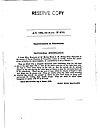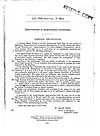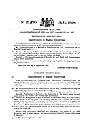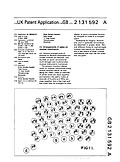Posted 15 December 2004
Historic Concertina Patents
Robert Gaskins
Full scanned copies of nine historic concertina patents, 1829–1986.
The portfolio includes three early patents by Charles Wheatstone and his brother William Wheatstone
(1829, 1844, 1861) covering the English concertina, John Hill Maccann's Duet patent (1884),
George Jones's Anglo patent (1884), the patent by James Alsepti and Richard Ballinger for the
“bowing valve” (1885, useful for dating instruments incorporating it),
John Butterworth's patent for the Crane Duet system (1896),
Kaspar Wicki's patent for the Wicki-Hayden Duet system (1896), and Brian
Hayden's much later patent (1986) for the same system.
None of these patents has any current force, all have either lapsed or been abandoned.
-
 Improvements in Concertinas, &c. (1861)
Improvements in Concertinas, &c. (1861)
-
by William Wheatstone
-
British Patent No. 2289 of 1861, Provisional Specification (14 September 1861) and
Specification (14 March 1862) with thirty-three figures. 38 pages.
"Improvements in Concertinas, &c.".
Improvements on the preceding concertina patents,
including a duet arrangement which reappears eighty years later
in one of the "Wheatstone Edeophones".
-
Posted 15 November 2001
-
» read full document in pdf
-
 Improvements in Concertinas (1884)
Improvements in Concertinas (1884)
-
by John Hill Maccann
-
British Patent No. 4752 of 1884, Provisional Specification (12 March 1884)
and Complete Specification (18 November 1884) with two figures. 4 pages.
The one and only patent dealing with the Maccann Duet concertina.
Maccann's invention creates a fully chromatic Duet (capable of playing
in all key signatures) based on the older diatonic Wheatstone “duett” system.
-
Posted 15 November 2001
-
» read full document in pdf
-
 Improvements in Anglo-German Concertinas (1884)
Improvements in Anglo-German Concertinas (1884)
-
by George Jones
-
British Patent No. 9314 of 1884, 23 June 1884 with two figures. 2 pages.
Jones describes a 42-key Anglo concertina, which is a
fully chromatic Anglo “ to enable the performer to play music in every key”,
based on the older diatonic 10-key and 20-key German models.
-
Posted 15 January 2004
-
» read full document in pdf
-
 Improvements in Concertinas (1885)
Improvements in Concertinas (1885)
-
by James Alsepti and Richard Ballinger
-
British Patent No. 8290 of 1885, Provisional Specification (08 July 1885)
and Complete Specification (08 April 1886) with two figures. 5 pages.
The “bowing valve” patent. These valves were for
English concertinas, providing a feature not present in the Wheatstone
designs, and were promoted by Lachenal.
-
Posted 22 December 2003
-
» read full article in pdf
-
 Improvements in English Concertinas (1896)
Improvements in English Concertinas (1896)
-
by John Butterworth
-
British Patent No. 21,730, Provisional Specification,
(28 September 1896), and Complete Specification (29 June 1897), with
two figures. 3 pages.
The patent describing the “Crane” (or “Triumph”) duet concertina system.
Crane & Sons Ltd. were large musical instrument manufacturers in Liverpool.
The system was adopted by the Salvation Army under the name “Triumph” from 1912, and eventually
Wheatstone was claiming it was because of “the disposition of the keys being more suited
to the playing of sacred music”.
-
Posted 15 February 2003
-
» read full article
-
 Tastatur für Musikinstrumente (1896)
Tastatur für Musikinstrumente (1896)
-
by Kaspar Wicki
-
Switzerland Patent Nr. CH13329, dated 30 Oktober 1896. 2 pages, 1
illustration. This patent describes a keyboard system identical to
the Hayden system which was independently re-discovered 90 years
later. “The keys or buttons … are arranged in such a way that one
can play in all key signatures using the same fingering. The notes
which are adjacent left-to-right on one row are always one full tone
from each other. Notes in the adjacent row are the associated fifths
(in the other direction the associated fourths) and notes two rows
away in each direction are the octaves.” [Translated from the German
original.]
-
Posted 01 March 2004
-
» read full document in pdf
-
 Arrangements of Notes on Musical Instruments (1986)
Arrangements of Notes on Musical Instruments (1986)
-
by Brian Hayden
-
British Patent No. GB2131592, 1986. 14 figures, 17 pages. This was an
independent re-discovery of the system
that had been patented by Kaspar Wicki ninety years earlier.
"Various arrangements of touches on Musical Keyboards
previously evolved are detailed … . The present invention
places notes on musical instruments along several adjacent
paths … . Keyboards for Organs, Accordions, and in
particular Concertinas are described in greater detail … ."
[from the Application].
Date Filed: 02.12.1982;
Patent Granted with effect from 20.08.1986;
Date of Last Renewal: 29.11.1989;
Date Not in Force: 02.12.1990;
Patent Ceased on 02.12.1990.
[Patents Register Entry, UK Patent Office]
-
Posted 01 September 2003
-
» read full document in pdf
Do you know another resource that we should include?
Tell us about it.
Reprinted from the Concertina Library
http://www.concertina.com
© Copyright 2000– by Robert Gaskins
|

Illustration from the earliest
Wheatstone Patent (1829)
|










